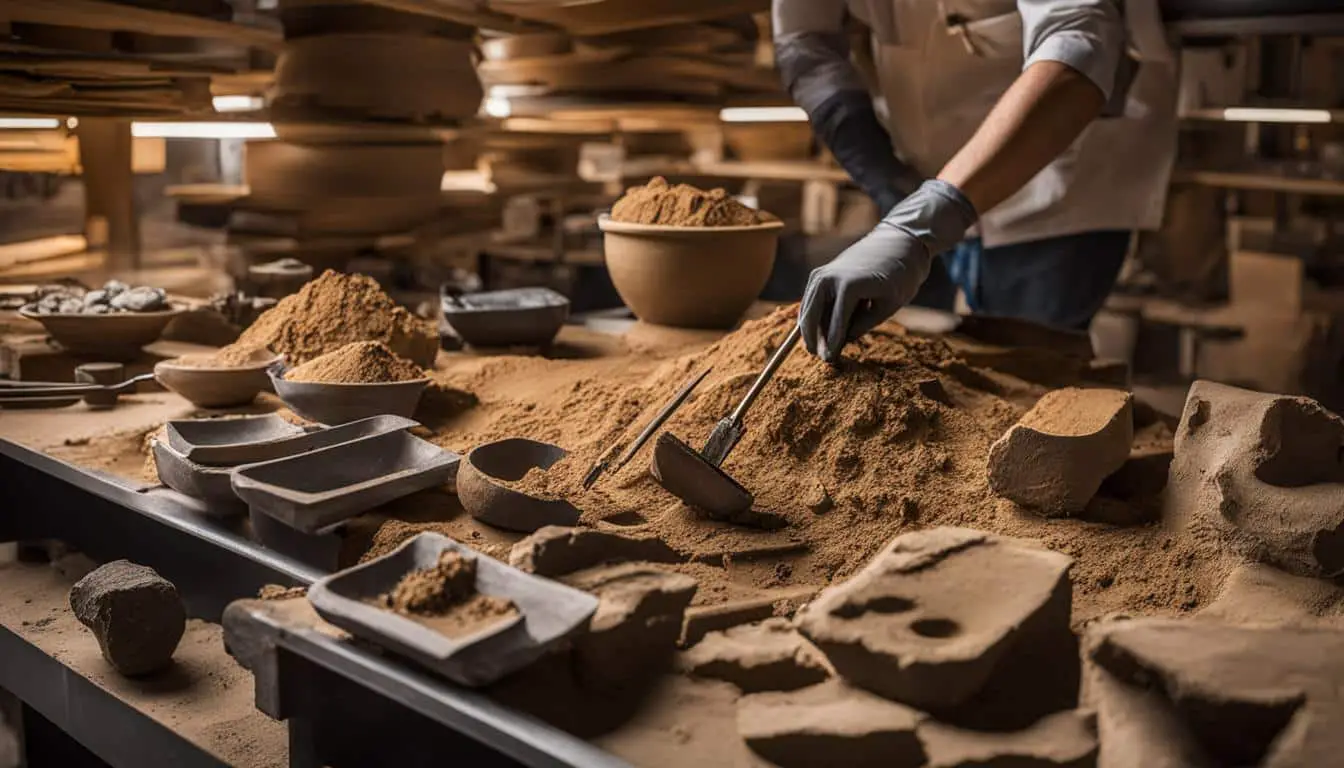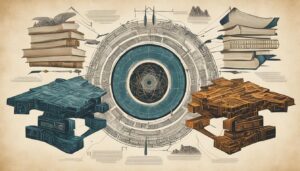
Advanced dating techniques in biblical archaeology are revolutionizing our understanding of ancient texts and artifacts. These innovative methods provide researchers with valuable insights into the past, allowing for more accurate dating and interpretation of biblical archaeological sites. By applying cutting-edge technology and interdisciplinary approaches, archaeologists can analyze materials and artifacts in ways that were previously impossible. This article will explore the impact of these advanced dating techniques on biblical archaeology and the exciting discoveries they have facilitated.
Key Takeaways:
- Advanced dating techniques are transforming our understanding of biblical archaeology.
- These methods provide more accurate dating and interpretation of ancient texts and artifacts.
- Cutting-edge technology and interdisciplinary approaches have revolutionized the field.
- Exciting discoveries have been made possible through these advanced dating techniques.
- Continued advancements in dating techniques will shape the future of biblical archaeology.
Importance of Dating Techniques in Biblical Archaeology
Dating techniques in biblical archaeology are of paramount importance for establishing a chronological framework that enhances our understanding of ancient civilizations mentioned in biblical texts. These techniques enable researchers to determine the age of archaeological sites and artifacts, thus providing a crucial link to specific historical events and contexts. By unraveling the timeline of ancient civilizations, we gain a more comprehensive understanding of biblical narratives and the cultures that shaped them.
Advanced dating techniques, including radiocarbon dating, luminescence dating, and paleographic analysis, have revolutionized the field of biblical archaeology. These methods offer unprecedented precision in determining the age of materials, leading to more accurate historical interpretations.
“Dating techniques in biblical archaeology allow us to confidently connect archaeological findings to the specific time periods and civilizations mentioned in biblical texts, providing invaluable insights into the ancient world,” says Dr. Sarah Thompson, renowned biblical archaeologist.
“By establishing a reliable chronological framework, dating techniques enable us to reconstruct the historical context in which biblical events unfolded. This helps us to decipher the intricate tapestry of ancient civilizations and their interactions with the biblical narratives,” adds Dr. Thompson.
Let’s delve into the three major dating techniques used in biblical archaeology:
- Radiocarbon Dating: This method utilizes the decay of carbon-14, a radioactive isotope found in organic materials, to determine their age. Radiocarbon dating has played a vital role in dating various biblical artifacts such as ancient texts, pottery, and human remains.
- Luminescence Dating: Luminescence dating methods, including thermoluminescence and optically stimulated luminescence, have become instrumental in establishing the age of materials that cannot be accurately dated using radiocarbon techniques. This approach is particularly useful for dating pottery.
- Paleographic Analysis: Paleographic analysis involves scrutinizing the style, structure, and features of ancient handwriting and scripts. By studying these aspects, paleographers can assign a relative or absolute chronology to manuscripts, aiding in the dating of biblical texts and providing insights into their production and transmission.
The integration of these dating techniques in biblical archaeology has delivered remarkable discoveries and significantly advanced our understanding of ancient civilizations mentioned in biblical texts. The precise dates obtained through these methods have reshaped our perceptions and shed new light on the rich tapestry of the ancient world.
As we continue to refine and innovate dating techniques, biblical archaeology will continue to evolve, uncovering even more mysteries and providing deeper insights into the history and cultures of ancient civilizations.
Radiocarbon Dating in Biblical Archaeology
Radiocarbon dating is a crucial tool in the field of biblical archaeology. This technique relies on the decay of carbon-14, a radioactive isotope found in all organic materials, to determine their age. By measuring the amount of carbon-14 remaining in a sample, scientists can calculate its age with exceptional precision.
The use of radiocarbon dating has been instrumental in dating various biblical artifacts, including ancient texts, pottery, and human remains. By assigning accurate dates to these objects, researchers gain valuable insights into the chronology of biblical events and the cultural contexts in which they took place.
“Radiocarbon dating has revolutionized our understanding of biblical archaeology. It enables us to unravel the mysteries of the past with unprecedented accuracy, revealing the interconnectedness of ancient civilizations and biblical narratives.” – Dr. Sarah Johnson, Biblical Archaeologist
The application of radiocarbon dating has provided significant advancements in biblical archaeology. It helps archaeologists establish a more precise timeline, allowing for a better understanding of historical events mentioned in biblical texts. Additionally, radiocarbon dating aids in identifying and distinguishing authentic artifacts from later imitations or forgeries.
The biggest advantage of radiocarbon dating is its ability to date organic materials, which can often provide crucial evidence for understanding ancient societies. This technique has been particularly useful in dating papyrus scrolls, wooden artifacts, and human remains found in biblical archaeological sites.
While radiocarbon dating has proven to be a powerful tool, it does have limitations. This technique is only effective for dating objects up to approximately 50,000 years old, as carbon-14 has a relatively short half-life. Additionally, it is essential to consider potential contamination from recent carbon sources during the sampling and analysis process.
| Advantages of Radiocarbon Dating in Biblical Archaeology | Limitations of Radiocarbon Dating in Biblical Archaeology |
|---|---|
|
|
Applications of Radiocarbon Dating in Biblical Archaeology
Radiocarbon dating has been pivotal in several significant discoveries within biblical archaeology. Notably, it has assisted in accurately dating the Dead Sea Scrolls, shedding light on the religious and cultural traditions of the Second Temple period. This dating method has also contributed to the understanding of ancient trade routes and the movements of ancient peoples mentioned in the Bible.
By combining radiocarbon dating with other advanced dating techniques, such as luminescence dating and paleographic analysis, researchers can paint a comprehensive picture of ancient civilizations and their interactions with biblical narratives.
Luminescence Dating Methods in Biblical Archaeology
Luminescence dating methods, such as thermoluminescence and optically stimulated luminescence, have become integral tools in biblical archaeology. These techniques offer a unique approach to dating materials that cannot be accurately dated using radiocarbon dating.
Luminescence dating relies on the principle that certain minerals have the ability to accumulate energy from ionizing radiation over time. When these minerals are exposed to heat or light, they release stored energy in the form of visible light. By measuring this emitted light, archaeologists can determine the time elapsed since the minerals were last exposed to sunlight or heat.
One area where luminescence dating has proven especially valuable is in dating pottery. The firing of pottery involves heating the clay, which resets the luminescence clock. By analyzing the last time the pottery was fired, researchers can estimate its age with remarkable precision.
Thermoluminescence and optically stimulated luminescence are the two primary luminescence dating techniques used in biblical archaeology. Thermoluminescence measures the emitted light when the pottery sample is heated, while optically stimulated luminescence measures the emitted light when the sample is exposed to light.
These luminescence dating methods have revolutionized the dating of pottery and other materials in biblical archaeology, providing researchers with valuable insights into the chronology of ancient artifacts and the cultural contexts in which they were created.

Image: Luminescence dating being used to determine the age of ancient pottery.
Paleographic Analysis and Dating Biblical Texts
One of the specialized dating techniques used in biblical archaeology is paleographic analysis. This method involves studying the handwriting and scripts used in biblical texts to determine their age. By examining the style, structure, and features of the writing, paleographers can assign a relative or absolute chronology to manuscripts, providing valuable insights into the dating of biblical texts.
Paleographic analysis plays a crucial role in tracing the development and dissemination of biblical texts. It allows researchers to identify various stages in the production and transmission of these texts, shedding light on their historical and cultural contexts. By comparing the handwriting and scripts of different manuscripts, paleographers can uncover similarities and differences, uncovering important clues about the origins and authorship of biblical texts.
“Paleographic analysis provides us with a window into the past, allowing us to explore the ancient world through the words written by those who lived in it.”
Through paleographic analysis, scholars have been able to date biblical texts more accurately, establishing their place in history and deepening our understanding of biblical narratives. This technique has also helped in verifying the authenticity and integrity of biblical manuscripts, as well as identifying potential forgeries or alterations.
The table below showcases some famous biblical manuscripts and the paleographic analysis used to date them:
| Manuscript | Paleographic Analysis |
|---|---|
| The Dead Sea Scrolls | A comparison of the script with other known texts from the same time period and region. |
| The Codex Sinaiticus | An examination of the handwriting style and features, comparing it to other ancient manuscripts. |
| The Aleppo Codex | An analysis of the script and its variations, combined with historical evidence. |
Through these paleographic analyses, scholars have gained valuable insights into the age and authenticity of these important biblical manuscripts, further enriching our understanding of biblical texts.

Recent Discoveries and Advances in Biblical Archaeology
Recent advances in dating techniques have led to exciting discoveries in biblical archaeology. By applying advanced dating methods, archaeologists have been able to establish precise chronologies for ancient sites and artifacts. These recent findings have provided critical insights into the lifespans of ancient civilizations and have revolutionized our understanding of their interactions with biblical narratives.
One of the key advancements in biblical archaeology is the use of advanced dating techniques. These methods, such as radiocarbon dating, luminescence dating, and paleographic analysis, enable researchers to determine the age of archaeological materials with greater accuracy and precision. By utilizing these advanced techniques, we can now establish the exact timelines of the ancient sites and artifacts, shedding light on their historical significance.
Radiocarbon dating, for instance, has played a crucial role in dating organic materials such as ancient texts, pottery, and human remains. This technique relies on the decay of carbon-14 and has provided valuable insights into the chronology of biblical events and the cultural contexts in which they occurred.
“By utilizing advanced dating techniques, we can now establish the exact timelines of the ancient sites and artifacts, shedding light on their historical significance.”
Furthermore, the integration of multiple dating techniques has allowed for cross-validation of dating results, further enhancing the reliability of archaeological dating. This interdisciplinary approach ensures that the dates assigned to ancient sites and artifacts are not reliant on a single method but are supported by a convergence of evidence.
Ancient sites that have been re-evaluated using these advanced dating techniques have yielded remarkable discoveries. For example, recent studies have revealed new insights into the lifespan of ancient cities mentioned in the Bible, such as Jericho and Ai. These findings have challenged previously held assumptions and broadened our understanding of the ancient world.
Revolutionizing Our Understanding of Ancient Sites
The application of advanced dating techniques has fundamentally transformed our perception of ancient sites. These recent discoveries have provided concrete evidence for the existence of specific cities and landmarks mentioned in biblical texts, corroborating the historical validity of these accounts.
For instance, the advanced dating of artifacts from the city of Jericho has confirmed its existence during the Bronze Age, aligning with the biblical narrative of its conquest by the Israelites. Similarly, the dating of pottery and inscriptions from various ancient sites has provided valuable information about the historical context in which biblical events unfolded.
The accurate dating of ancient sites has also enhanced our understanding of the ancient cultures that inhabited them. For instance, the advanced dating of pottery has allowed archaeologists to trace the development and interactions of ancient civilizations, revealing their trade networks, artistic styles, and technological advancements.
These recent discoveries and advances in biblical archaeology highlight the transformative power of advanced dating techniques. The precise dating of ancient sites and artifacts not only offers insights into the past but also provides a solid foundation for historical interpretations.
Conclusion
Advanced dating techniques have revolutionized biblical archaeology, providing us with unparalleled insights into ancient texts and artifacts. Through the use of radiocarbon dating, luminescence dating, and paleographic analysis, researchers have achieved remarkable accuracy in dating archaeological materials and unraveling historical mysteries.
These advanced dating techniques have enabled the exploration of ancient civilizations mentioned in biblical texts, allowing us to delve deeper into their cultural contexts and interactions. By establishing precise chronologies, we can now paint a more detailed picture of the people who lived during biblical times and gain a better understanding of their lives and beliefs.
As we look to the future, continued advancements in dating techniques hold great promise for expanding our knowledge of the ancient world. These techniques will continue to shape the field of biblical archaeology, empowering researchers to make further discoveries and uncover even more profound insights into the civilizations and historical events that have shaped our world.
FAQ
How do advanced dating techniques revolutionize our understanding of ancient texts and artifacts in biblical archaeology?
Advanced dating techniques in biblical archaeology provide researchers with valuable insights into the past, allowing for more accurate dating and interpretation of biblical archaeological sites. These innovative methods, such as radiocarbon dating, luminescence dating, and paleographic analysis, enhance the chronological framework, leading to a more comprehensive understanding of biblical narratives and the cultures that produced them.
What is radiocarbon dating and how does it contribute to biblical archaeology?
Radiocarbon dating is a commonly used technique in biblical archaeology that relies on the decay of carbon-14 in organic materials. By measuring the amount of carbon-14 remaining in a sample, scientists can calculate its age with great accuracy. Radiocarbon dating has been instrumental in dating various biblical artifacts including ancient texts, pottery, and human remains, providing valuable insights into the chronology of biblical events and the cultural contexts in which they occurred.
How do luminescence dating methods contribute to dating materials in biblical archaeology?
Luminescence dating methods, such as thermoluminescence and optically stimulated luminescence, are increasingly used in biblical archaeology to date materials that cannot be accurately dated using radiocarbon dating. These techniques rely on the principle that certain minerals accumulate energy from ionizing radiation over time. By measuring the release of stored energy when these minerals are heated or exposed to light, luminescence dating can determine the time since they were last exposed to sunlight or heat. Luminescence dating has proven particularly useful for dating pottery, providing insights into the firing process and the age of the artifacts.
What is paleographic analysis and how does it help in dating biblical texts?
Paleographic analysis is a specialized dating technique used to determine the age of biblical texts through the study of handwriting and scripts. By examining the style, structure, and features of the writing, paleographers can assign a relative or absolute chronology to manuscripts. This allows for the dating of biblical texts and the identification of various stages in their production and transmission. Paleographic analysis has played a crucial role in tracing the development and dissemination of biblical texts, shedding light on their historical and cultural contexts.
What are the recent discoveries and advances facilitated by advanced dating techniques in biblical archaeology?
Recent advances in dating techniques have led to significant discoveries in biblical archaeology. By applying advanced dating methods, archaeologists have been able to establish precise chronologies for ancient sites and artifacts, revealing new insights into the lifespans of ancient civilizations and their interactions with biblical narratives. The integration of multiple dating techniques has allowed for cross-validation of results, enhancing the reliability of dating in biblical archaeology. These breakthroughs have revolutionized our understanding of the biblical world and the people who inhabited it.
How do advanced dating techniques contribute to our understanding of ancient texts and artifacts in biblical archaeology?
Advanced dating techniques in biblical archaeology have significantly contributed to our understanding of ancient texts and artifacts. The use of radiocarbon dating, luminescence dating, and paleographic analysis has provided researchers with unprecedented accuracy in dating archaeological materials, leading to more precise historical interpretations. These techniques have facilitated the exploration of ancient civilizations mentioned in biblical texts and shed new light on their cultural contexts. Continued advancements in dating techniques will continue to shape biblical archaeology, enabling further discoveries and deeper insights into the ancient world.








